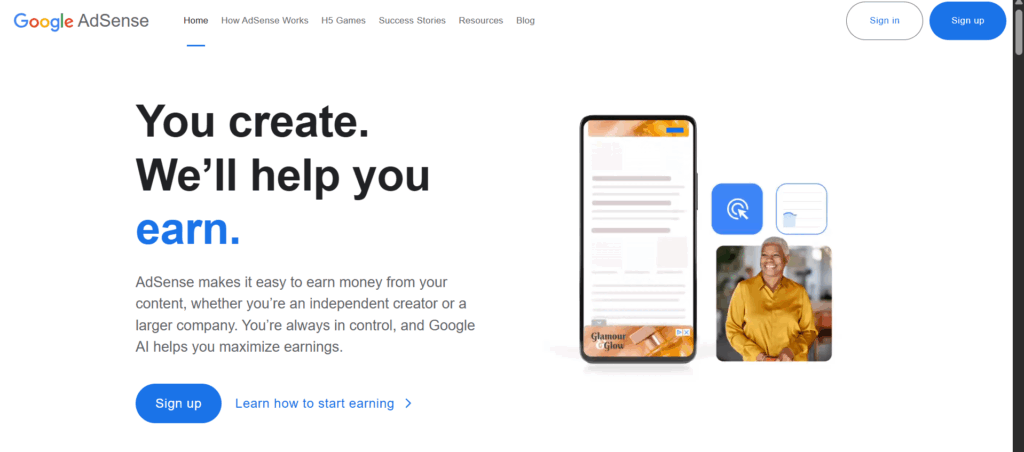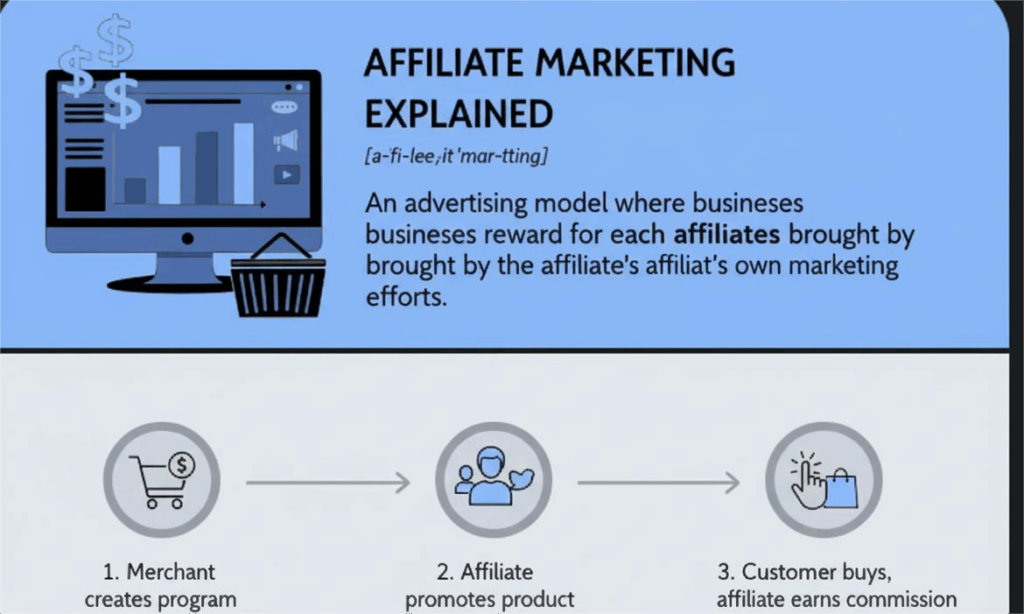Have you ever wondered which makes more money for bloggers, AdSense or affiliate marketing? You’re not alone.
In 2025, content creators are earning more than ever before, yet the competition is fierce.
Choosing the right monetization strategy can be the difference between earning a few extra dollars a month and building a full-time, sustainable income from your blog.
AI-driven content is changing the game. Search algorithms keep evolving. New privacy regulations are reshaping how traffic and revenue flow online.
That’s why understanding the strengths and limitations of each monetization option has never been more important.
In this article, we’ll take a deep dive into Affiliate Marketing vs AdSense for Blogs. You’ll discover how each works, its pros and cons, and its real earning potential based on the latest 2025 data.
No matter your experience level, this guide will show you how to choose the right strategy to grow and earn more this year.
What Is AdSense?

Google AdSense is one of the oldest and most trusted ad programs for bloggers.
It is a pay-per-click (PPC) advertising program that allows bloggers to earn money by displaying ads on their websites.
Every time a visitor clicks an ad or views it (depending on the ad type), you earn money.
Launched by Google, it connects advertisers with publishers through an automated system.
How AdSense Works for Blogs
- Ad Placement
You integrate AdSense code into your blog, and Google fills the ad spaces with relevant ads based on your content and visitor data.
- Earning Model:
Primarily CPM (cost per mille, or per 1,000 impressions) and CPC (cost per click). You earn when visitors view or click on ads.
- Payout Threshold
Minimum $100, with payments via direct deposit or check.
In 2025, AdSense remains a staple for passive income, especially for blogs with high traffic volumes. However, earnings can fluctuate due to ad blockers, seasonal trends, and Google’s algorithm updates.
AdSense offers simplicity, but it’s not without drawbacks. Here’s a balanced look:
Pros
- Easy Setup: Minimal effort to integrate and manage ads.
- Passive Income: Earn from impressions and clicks without direct sales involvement.
- Scales with Traffic: Ideal for high-traffic blogs; premium networks like Ezoic or Mediavine can boost RPMs.
- Reliable Payments: Backed by Google, with consistent payouts.
Cons
- Low Earnings per Visitor: Average RPM ranges from $1-5 in low-tier countries, up to $10-30 in high-value niches like finance in the US.
- Ad Fatigue and Blockers: Users increasingly use ad blockers, reducing revenue.
- Policy Risks: Easy to get banned for violations like invalid clicks.
- Limited Control: No say over ad content, which can sometimes mismatch your blog’s tone.
For a blog with 100,000 monthly pageviews, AdSense might yield $100-200 in low-CPM regions or $500-2,000 with optimized networts.
Average AdSense earnings in 2025:
- $0.10 – $2.50 per click, depending on niche and audience location.
- $1 – $10 per 1,000 views (CPM) for most niches.
What Is Affiliate Marketing?

Affiliate marketing means promoting other people’s products or services and earning a commission for each sale or action generated through your referral link.
For example, if you write a review about a hosting service and someone buys using your link, you earn a commission.
How Affiliate Marketing Works
- You join an affiliate program (e.g., Amazon Associates, Impact, ShareASale).
- You get a unique tracking link.
- You promote it on your blog posts, guides, or emails.
- When a visitor buys, you earn a percentage of the sale.
Pros and Cons of Affiliate Marketing for Blogs in 2025
Affiliate marketing empowers bloggers with more control, but it demands strategy.
Pros
- Higher Potential Earnings: Commissions can be lucrative; average monthly income for affiliates is around $8,038, with top earners hitting $10,000+.
- Targeted Revenue: Promote products aligned with your niche for better conversions.
- Flexibility: No ad clutter; integrate links naturally into content.
- Scalable with Audience Building: Email lists and SEO can amplify earnings without relying on ad networks.
Cons
- Effort-Intensive: Requires creating high-quality, persuasive content.
- Variable Income: Earnings depend on conversions, not just traffic—seasonal fluctuations affect 3.33% of marketers.
- Competition: Saturated niches like fitness or finance demand unique angles.
- Payment Delays: Some programs have 30-60 day holds on commissions.
Experienced bloggers (5-10 years) average $2,621 monthly from affiliates, scaling to $5,624+ for veterans.
Earnings Comparison: Which Pays More in 2025?
The million-dollar question: Affiliate Marketing vs AdSense—which pays more? It depends on your blog’s niche, traffic, and strategy, but data leans toward affiliates for higher upside.
| Metric | AdSense | Affiliate Marketing |
| Beginner Monthly Earnings | $0-100 (low traffic) | $0-1,000 |
| Average Monthly Income | $100-200 for 100k views (low CPM) | $8,038 |
| High-Traffic Potential (100k+ views) | $500-2,000 | $10,000+ |
| Top Niches | Finance ($10-30 RPM) | Personal Finance ($9,100 median) |
Affiliate marketing consistently outperforms AdSense in targeted niches. For example, food bloggers earn a median of $9,169 per month through affiliate partnerships, while AdSense earnings often remain lower unless the site reaches massive traffic levels.
On average, businesses see a $6.50 return for every $1 spent on affiliate marketing, a clear sign of its efficiency and profitability.
In 2025, affiliate marketers are reaping even more rewards, driven by mobile traffic (now accounting for 62%) and high-paying niches like fitness tech, where monthly earnings can average $12,475.
AdSense, while still reliable, typically offers lower returns per visitor. In fact, many bloggers report that affiliate programs now account for over 42% of their total income, a strong indicator of where the real growth lies.
Factors Influencing Earnings in 2025
In 2025, blog monetization is about strategy, audience quality, and adaptability. Several key factors determine how much you earn from either Affiliate Marketing or AdSense.
1. Niche Selection
Your blog’s niche plays a huge role in your earning potential. Some niches attract higher-paying advertisers and more profitable affiliate programs.
- High-paying affiliate niches in 2025 include personal finance, health and wellness, software, web hosting, and technology.
- These industries offer higher commission rates, sometimes as much as 40–60% per sale, because products have strong buyer intent.
- In contrast, general niches like entertainment or lifestyle tend to perform better with AdSense, where income depends on traffic volume rather than conversions.
Choosing the right niche is the first step toward maximizing your income.
2. Traffic Quality
Not all traffic is equal.
Affiliate marketing thrives on engaged and targeted audiences who trust your recommendations. Even a few hundred loyal readers can generate consistent affiliate sales if your content aligns with their needs.
On the other hand, AdSense works best with large-scale traffic. The more visitors you attract, the more ad impressions and clicks you get, which means higher CPM and CPC earnings.
In short:
- Affiliates rely on quality over quantity.
- AdSense rewards volume over engagement.
3. Emerging Trends in 2025
The digital scape is evolving fast. AI-driven search engines and voice assistants are reshaping how people discover content.
To stay ahead, successful bloggers are:
- Building topic clusters that establish authority around key subjects.
- Creating human-centric content that balances SEO with authenticity.
- Diversifying traffic sources by using email newsletters, YouTube, and social media to reduce dependency on search algorithms.
These trends reward creators who adapt and focus on long-term audience relationships rather than short-term clicks.
4. The Hybrid Approach
In 2025, many top bloggers are blending both Affiliate Marketing and AdSense to achieve a stable, scalable income.
This hybrid model allows you to earn from every visitor, whether they click an ad or buy through your affiliate link.
For example:
- Use AdSense on high-traffic informational posts that attract general audiences.
- Use affiliate links on review or comparison articles where readers are ready to make a purchase.
By combining both methods strategically, you create a balanced revenue stream that grows with your content and stays resilient even as algorithms and market trends change.
2025 Trends in Blog Monetization
Blogging in 2025 is no longer just about churning out content or chasing page views.
The focus has shifted toward purpose, value, and reader connection.
Successful bloggers are blending creativity with strategy, and the trends below are shaping how online creators earn today.
1. AI Integration with a Human Touch
AI tools now play a major role in content creation, from generating topic ideas to optimizing SEO.
However, blogs that truly stand out are the ones that humanize AI output.
Search engines in 2025 reward authenticity, originality, and emotional depth. Bloggers who combine AI efficiency with genuine storytelling are seeing stronger rankings and better reader engagement.
2. Income Diversification
The smartest creators are no longer relying on a single income source.
Beyond ads and affiliate marketing, bloggers are branching into:
- Digital products such as eBooks, templates, or online courses often earn $100 to $1,000 per sale.
- Coaching or consulting services personalised to their niche.
- Sponsored content and collaborations with brands that align with their audience.
This diversification creates stability and opens multiple income streams that grow alongside the blog.
3. Interactivity and Engagement
Static content is fading. In 2025, interactive experiences like polls, quizzes, and gamified challenges are driving higher engagement.
These features keep readers on the page longer and strengthen trust, both essential for affiliate conversions and AdSense performance.
Gamification, in particular, is helping blogs turn casual visitors into loyal fans.
4. Paywalls and Exclusive Content
As audiences seek more depth and authenticity, premium content models are gaining popularity.
Bloggers are offering:
- Members-only articles,
- Private communities, or
- Exclusive newsletters for loyal readers willing to pay for added value.
This approach not only builds community but also creates a reliable stream of recurring income.
Affiliate Marketing’s Role in 2025
Among all these trends, affiliate marketing continues to align best with the modern blogging model.
It rewards trust-based relationships, adapts to privacy-focused changes, and offers higher ROI compared to traditional ads.
In a world where authenticity sells, affiliate partnerships remain one of the most profitable and sustainable ways to monetize a blog in 2025.
Conclusion
If you want consistent income from high-traffic content, go for AdSense.
If you want long-term, scalable, high-ticket income, choose Affiliate Marketing.
👉 In 2025, affiliate marketing is the clear winner for bloggers who want real profit and growth.
But remember, your success depends on your content quality, SEO strategy, and consistency.
Read more expert blogging tips and creative stories at iWayThrills.
